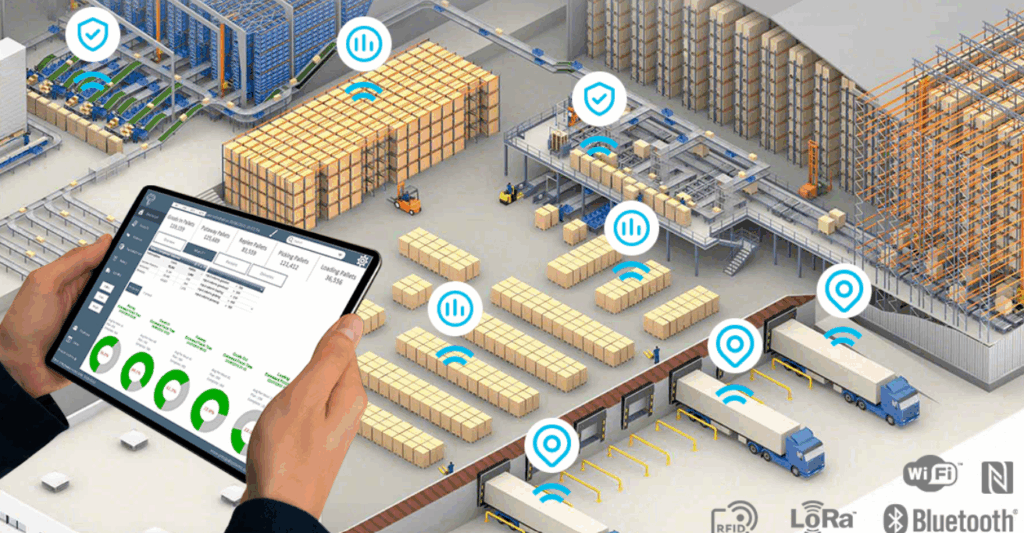
In today’s fast-paced supply chain and logistics landscape, warehouse efficiency has become a major driver of business success. As companies strive to improve turnaround times, minimize errors, and maximize space utilization, advanced technologies like the Internet of Things (IoT) and sensor systems have emerged as game-changers. The integration of IoT in warehouses has transformed traditional storage facilities into smart, connected hubs of productivity and automation.
What is IoT in the Warehouse Context?
The Internet of Things (IoT) refers to a network of interconnected devices that collect, share, and analyze data through sensors, software, and other technologies. When applied to warehouse operations, IoT devices enable real-time tracking, automation, predictive maintenance, and intelligent decision-making.
For instance, smart sensors can monitor inventory levels, detect temperature or humidity changes, and even track the movement of goods within the warehouse. These capabilities drastically improve the accuracy and speed of operations, reducing human error and enhancing overall warehouse efficiency.
Role of Sensor Technology in Warehousing
Sensor technology is a key enabler of IoT in warehouse environments. Different types of sensors are deployed to capture vital information such as:
- Temperature and humidity sensors: These ensure that sensitive items like pharmaceuticals, electronics, or perishable goods are stored under optimal conditions.
- Motion and proximity sensors: These are used for automated lighting, security monitoring, and tracking employee movements for safety and productivity.
- RFID (Radio Frequency Identification) and barcode sensors: These help in real-time inventory tracking and automated stock updates.
- Vibration and pressure sensors: Useful in monitoring the wear and tear of machinery and forklifts, helping in proactive maintenance and reducing downtime.
Together, these sensor systems provide warehouse managers with actionable insights that drive smarter operations and better resource allocation.
Key Benefits of IoT and Sensor Technology in Warehouses
- Real-Time Inventory Tracking
IoT-enabled sensors, such as RFID tags and GPS trackers, offer live updates on inventory status. This minimizes the chances of stockouts or overstocking and enhances order accuracy. Warehouse personnel can instantly locate any item, improving order fulfillment rates.
- Improved Space Utilization
Smart sensors help monitor space usage and suggest optimal storage configurations. With data-driven insights, warehouses can reduce wasted space, improve layout efficiency, and adapt quickly to changing inventory levels.
- Predictive Maintenance
IoT devices can monitor the condition of warehouse equipment like conveyors, forklifts, and automated systems. Early detection of mechanical issues allows for scheduled maintenance, preventing unexpected breakdowns and costly delays.
- Enhanced Safety
Worker safety is paramount in any warehouse. IoT sensors detect hazardous conditions such as gas leaks, temperature anomalies, or unauthorized access. They can also be integrated with wearables to monitor worker health and fatigue, reducing the risk of accidents.
- Energy Efficiency
Smart lighting, HVAC systems, and energy meters connected through IoT can significantly reduce energy consumption. By adjusting energy usage based on real-time occupancy and environmental conditions, warehouses can lower utility costs and support sustainability efforts.
- Seamless Integration with WMS
Modern IoT systems integrate easily with Warehouse Management Systems (WMS), enabling centralized control of inventory, operations, and analytics. This leads to better planning, smoother workflows, and reduced manual input.
Also Read: Warehouse Management Systems (WMS) Trends in 2025
Case Study: Implementing IoT in a Modern Warehouse
Consider a growing warehouse in Ludhiana that handles a variety of consumer goods. The management decided to implement an IoT-based system combined with smart sensors. Here’s how the transformation unfolded:
- RFID tags were installed on every pallet and shelf for precise inventory control.
- Environmental sensors were used in storage areas for temperature-sensitive items.
- Proximity sensors were installed to prevent collisions between forklifts and workers.
- A centralized dashboard displayed real-time metrics and alerts.
The results? A 25% improvement in order picking time, a 30% reduction in product damage, and a noticeable drop in operational costs — all within the first year of adoption.
Challenges and Considerations
While the benefits of IoT in warehouses are clear, implementation does come with some challenges:
- Initial investment costs for sensors, connectivity, and integration can be high.
- Data security is critical, as connected systems can be vulnerable to cyber threats.
- Employee training is necessary to adapt to new systems and workflows.
- Scalability should be considered when choosing IoT platforms to accommodate future growth.
To address these concerns, companies must work with experienced technology partners and choose solutions that offer flexibility, security, and long-term support.
Future Outlook
The future of warehousing lies in automation and data intelligence. IoT and sensor technology in warehouses will continue to evolve with advancements like AI, machine learning, and 5G connectivity. These innovations will push warehouse efficiency to new levels, offering unparalleled visibility, control, and responsiveness.
Small and mid-sized businesses are also beginning to explore IoT adoption as the cost of sensors and cloud services becomes more affordable. Whether it’s a global logistics hub or a local warehouse in Ludhiana, the digital transformation journey has begun.
Conclusion
Incorporating IoT and sensor technology is no longer a luxury but a necessity for competitive warehouse operations. From real-time tracking and predictive maintenance to improved safety and space optimization, the impact on warehouse efficiency is profound. Businesses that invest in smart warehousing today are not only future-proofing their operations but also setting the stage for faster, safer, and more sustainable growth.
If you’re considering upgrading your warehouse systems, now is the time to explore how IoT can bring measurable results to your logistics network — whether you operate a multinational facility or a local warehouse in Ludhiana.